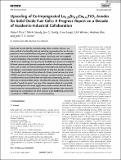Files in this item
Upscaling of co-impregnated La0.20Sr0.25Ca0.45TiO3 anodes for solid oxide fuel cells : a progress report on a decade of academic-industrial collaboration
Item metadata
| dc.contributor.author | Price, Robert | |
| dc.contributor.author | Cassidy, Mark | |
| dc.contributor.author | Grolig, Jan G. | |
| dc.contributor.author | Longo, Gino G. | |
| dc.contributor.author | Weissen, Ueli G. | |
| dc.contributor.author | Mai, Andreas G | |
| dc.contributor.author | Irvine, John T. S. | |
| dc.date.accessioned | 2021-02-12T12:30:06Z | |
| dc.date.available | 2021-02-12T12:30:06Z | |
| dc.date.issued | 2021-02-12 | |
| dc.identifier | 272432395 | |
| dc.identifier | 9c724250-da97-4a89-9eb1-972ac7b39801 | |
| dc.identifier | 85101015349 | |
| dc.identifier | 000617135200001 | |
| dc.identifier.citation | Price , R , Cassidy , M , Grolig , J G , Longo , G G , Weissen , U G , Mai , A G & Irvine , J T S 2021 , ' Upscaling of co-impregnated La 0.20 Sr 0.25 Ca 0.45 TiO 3 anodes for solid oxide fuel cells : a progress report on a decade of academic-industrial collaboration ' , Advanced Energy Materials , vol. Early View , 2003951 . https://doi.org/10.1002/aenm.202003951 | en |
| dc.identifier.issn | 1614-6832 | |
| dc.identifier.uri | https://hdl.handle.net/10023/21419 | |
| dc.description | Funding: University of St Andrews and HEXIS AG, in addition to the EPSRC Grants: EP/M014304/1 “Tailoring of Microstructural Evolution in Impregnated SOFC Electrodes”, EP/L017008/1 “Capital for Great Technologies” EP/P024807/1 “Hydrogen and Fuel Cells Hub.” | en |
| dc.description.abstract | Solid oxide fuel cell (SOFC) stack technology offers a reliable, efficient, and clean method of sustainable heat and electricity co‐generation that can be integrated into micro‐combined heat and power (µ‐CHP) units for use in residential and small commercial environments. Recent years have seen the successful market introduction of several SOFC‐based systems, however, manufacturers still face some challenges in improving the durability and tolerance of traditional Ni‐based ceramic‐metal (cermet) composite anodes to harsh operating conditions, such as redox and thermal cycling, overload exposure, sulfur poisoning and coking, in unprocessed natural gas feeds, for long time periods. Creating a “silver bullet” anode material that solves all of these issues has been the focus of SOFC research of the past 20 years, however, very few materials are reported to address these issues at the button cell scale and, subsequently, successfully scale to industrial SOFC stacks. Therefore, the purpose of this review is to provide a “powder to power” overview of the academic‐industrial cross‐collaborative development of a novel, highly robust anode material, from the fundamental materials science performed in academic laboratories to the successful upscaling and incorporation into short stacks at a well‐established, commercial manufacturer of SOFC systems in an industrial setting. | |
| dc.format.extent | 21 | |
| dc.format.extent | 5838571 | |
| dc.language.iso | eng | |
| dc.relation.ispartof | Advanced Energy Materials | en |
| dc.subject | Catalyst impregnation | en |
| dc.subject | Collaboration | en |
| dc.subject | Fuel cell anodes, solid oxides | en |
| dc.subject | Stack testing | en |
| dc.subject | Upscaling | en |
| dc.subject | QD Chemistry | en |
| dc.subject.lcc | QD | en |
| dc.title | Upscaling of co-impregnated La0.20Sr0.25Ca0.45TiO3 anodes for solid oxide fuel cells : a progress report on a decade of academic-industrial collaboration | en |
| dc.type | Journal item | en |
| dc.contributor.sponsor | EPSRC | en |
| dc.contributor.sponsor | EPSRC | en |
| dc.contributor.institution | University of St Andrews. Centre for Designer Quantum Materials | en |
| dc.contributor.institution | University of St Andrews. School of Chemistry | en |
| dc.contributor.institution | University of St Andrews. EaSTCHEM | en |
| dc.identifier.doi | 10.1002/aenm.202003951 | |
| dc.description.status | Peer reviewed | en |
| dc.identifier.url | https://onlinelibrary.wiley.com/doi/10.1002/aenm.202003951 | en |
| dc.identifier.grantnumber | ep/l017008/1 | en |
| dc.identifier.grantnumber | EP/M014304/1 | en |
This item appears in the following Collection(s)
Items in the St Andrews Research Repository are protected by copyright, with all rights reserved, unless otherwise indicated.

